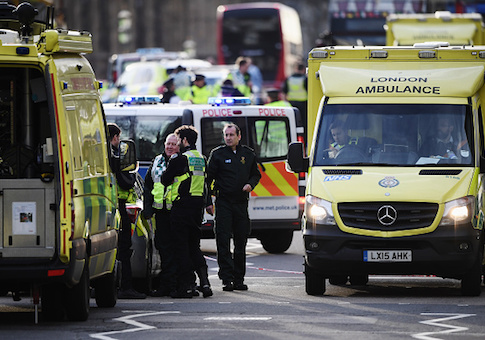The terrorist attack in London on March 22 was carried out by an Islamic jihadist who used a rented vehicle in an attack that killed five people and injured dozens more.
The use of vehicles to kill and injure in pursuit of jihad, or holy war, highlights a growing trend of ramming attacks—a tactic advocated by the Islamic State terror group and al Qaeda.
The terrorist, who was killed by police outside Parliament after he stabbed a guard to death, was identified as Khalid Masood.
Authorities said Monday Masood was not linked to the Islamic State. However, ISIS acknowledged the attacker as one of its Muslim "soldiers."
Masood sent encrypted communications through the WhatsApp messaging application shortly before conducting the rampage. Authorities are attempting to decipher the messages as part of an ongoing investigation.
Security remains tight in London and authorities have increased the alert level to "severe," indicating another attack is possible.
A State Department security report stated that Masood's attack is the third recent European jihadist attack using a truck or SUV.
"The March 22 attack bears the hallmarks of the types of actions that violent Islamist extremists, including ISIS, have encouraged in Europe," the March 23 report said.
Earlier ISIS-linked vehicle ramming attacks took place in Nice, France, in July and in Berlin in December.
"Though generally less deadly, the use of personal vehicles has been encouraged by ISIS, due to the relative ease with which such attacks can be successfully carried out and the difficulty in deterring them," the report said.
Lack of access to firearms has prompted terrorists with limited resources to turn to vehicle attacks and knife or other bladed weapons attacks.
In 2013, two terrorists linked to the Islamist group al Muhajiroun used a vehicle and knives to kill a British soldier in London. Ten years ago, two Islamists conducted a failed attack on Glasgow Airport using a vehicle filled with gas canisters.
Former CIA officer Brad Johnson said ISIS and al Qaeda have long used vehicles in attacks. Over the last few years, he said the groups had widened their tactical use of vehicles to include targeting civilians in "enemy" countries such as the recent attack in London.
"The terrorist groups have adopted these tactics to make it easy for attackers who might otherwise find it difficult to obtain weapons or explosives and have stated that they believe cars and knives instill as much or more 'fear' than guns and bombs," Johnson said.
"Their stated goal is to make sure that western societies live in a constant state of fear."
Johnson noted that the official magazines of ISIS and al Qaeda, Dabiq and Inspire, outlined detailed instructions on how cars and trucks can be employed to kill and wound civilians.
"In addition, ISIS in particular has 78 public channels in the Telegram messaging app as well as encrypted chat rooms where they also provide similar information and training to individuals or groups they are recruiting and training to commit terrorist acts," he noted.
Daveed Gartenstein-Ross, a terrorism expert with the Foundation for Defense of Democracies, said vehicles are being used more frequently by terrorists in attacks against Western countries.
"There have been three prominent vehicle attacks since last summer—including the Nice attack, the Berlin Christmas market attack, and the London attack," Gartenstein-Ross said.
"The day after the London attack, another such vehicle attack was thwarted, in Antwerp," he added.
There also have been other cases, including one in Germany, where ISIS operatives encouraged ramming attacks with vehicles.
The State Department report warned that terrorists' use of vehicle attacks is likely to trigger "emotionally disturbed persons" to conduct similar acts of violence. "Each new incident carries the risk of inspiring others to take similar action," the four-page report stated.
Five non-terrorist vehicle attacks took place between December 2014 and February. They included two ramming attacks in December 2014 in Dijon and Nantes, France; a June 2015 attack in Austria by a man driving an SUV into a crowd; a September 2016 attempt to drive a car into pedestrians in Vienna; and a driver who killed a pedestrian and injured two others in Heidelberg, Germany, last month.
The State Department security report said the London attack "appears to have been inspired by international terrorism."
The report said Masood may have had "virtual contact" with other terrorists or Syrian-based ISIS.
"The attack shows a level of premeditation in the selection of the target," the report said.
Masood, an Islamic convert, could have links to domestic terrorists. A sweep by British authorities in London and Birmingham netted 12 people who were detained as part of the ramming investigation. Nine were later released.
The daylight ramming involved Masood driving a rented SUV at high speed along a walkway of the Westminster bridge over the Thames Rivers. It was the first major terrorist attack in Britain since 2013 and a significant step in the Islamic State's efforts to strike Britain. Since then, security and police have thwarted at least 12 terror plots.
"Though a priority target for ISIS and other terrorist groups, over the past decade, the UK has been spared the type of attacks witnessed elsewhere in Western Europe," the report said.
"As a high-profile economic and political target, London is featured repeatedly in ISIS propaganda and the group’s calls for attacks," the report said.
The report by the State Department's Overseas Security Advisory Council, a security group that supports American businesses, said the attack is likely viewed as a success for ISIS but does not indicate an increased level of operational capability in Britain.
Terrorists in Britain "are likely to rely primarily on rudimentary tactics, including knife and vehicle attacks, due to the difficulty in obtaining firearms and explosives," the report said.
"However, the risk of a more sophisticated, internationally directed attack does exist throughout the region, though it remains a lower probability event as compared to the probability of additional homegrown attack attempts," the report said.
